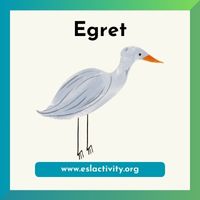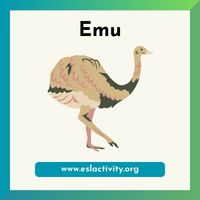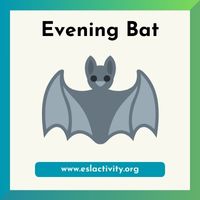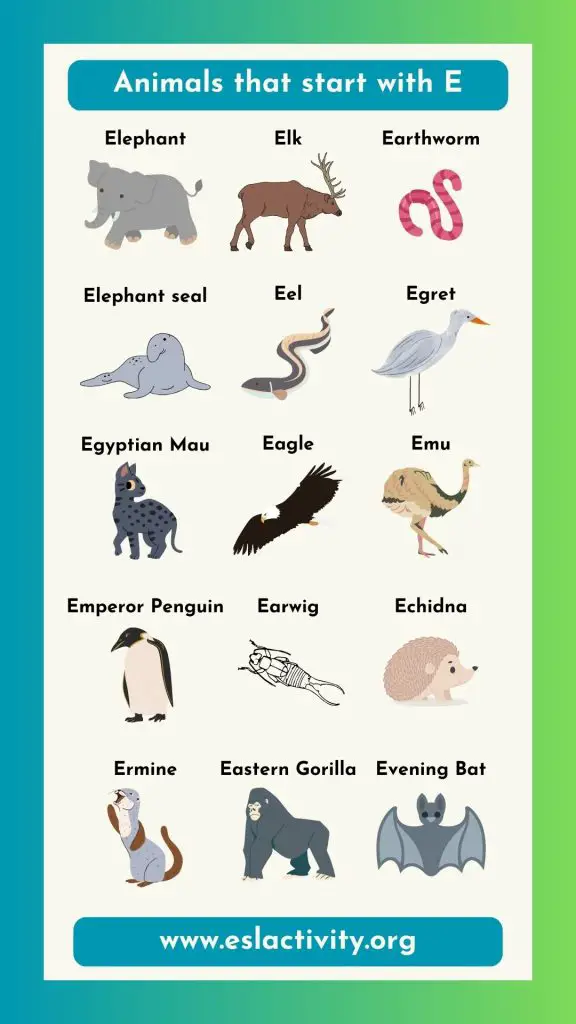Are you an animal lover? We got a list of animals that start with the letter “e.” See how many you know from this animal list. This animal vocabulary list will provide you with a chance to learn about different animals while building your English vocabulary. We will provide pictures of the animals as well as some fun facts about them.
List of Animals that Start with E
Here’s the list of animals that we will discuss in this article.
- Elephant
- Elk
- Earthworm
- Elephant seal
- Eel
- Egret
- Egyptian Mau
- Eagle
- Emu
- Emperor Penguin
- Earwig
- Eastern Coral Snake
- Eastern Box Turtle
- Echidna
- Ermine
- Eastern Gorilla
- Evening Bat
- English Bulldog
- Elf Owl
- Emperor Angelfish
Animals that Start with E

Eagle
Eagles are magnificent birds of prey known for their powerful beaks, sharp talons, impressive flying abilities, and keen eyesight.
Fun facts about eagles:
- Eagles build large nests, called eyries, in high locations like trees or cliffs.
- Some eagle species can reach speeds of over 100 miles per hour during flight.
- Eagles are skilled hunters, capturing prey that can be much larger than themselves.

Earthworm
Earthworms are important for soil health because they dig tunnels in the ground. They don’t have legs, but they’re long and thin.
Fun facts about earthworms:
- Earthworms have both male and female reproductive organs, and they exchange sperm with each other during a process called copulation.
- Earthworms can eat their own weight in organic matter every day, contributing to the decomposition of dead plant material.
- Earthworms have specialized cells in their skin that can detect light, allowing them to sense changes in their environment, even though they lack eyes.

Earwig
Earwigs are small insects with long bodies. They have pincers on their abdomen and are active at night. Their appearance is distinctive.
Fun facts about earwigs:
- Contrary to the common myth, earwigs do not crawl into human ears; they are harmless insects that prefer dark and damp environments.
- Earwigs are omnivores, feeding on a variety of organic matter, including plants, insects, and decaying material.
- Earwigs are equipped with specialized glands that release a foul-smelling liquid when they feel threatened, acting as a deterrent against predators.

Eastern Box Turtle
Eastern box turtles are small, terrestrial turtles characterized by a hinged shell, and they are known for their vibrant markings and unique lifestyle.
Fun facts about easter box turtles:
- Eastern box turtles have a remarkable ability to retract their limbs and close their hinged shell tightly, providing excellent protection from predators.
- Eastern box turtles turtles are long-lived, with some individuals reaching ages of over 100 years.
- Eastern box turtles are omnivores, enjoying a diet that includes a variety of foods such as fruits, insects, mushrooms, and vegetation.

Eastern Coral Snake
The eastern coral snake is a venomous snake with distinctive red, yellow, and black bands, known for its potent neurotoxic venom and secretive nature.
Fun facts about eastern coral snakes:
- The saying “Red touch yellow, kill a fellow; red touch black, venom lack” is a rhyme to help distinguish the eastern coral snake from nonvenomous look-alike snakes with similar color patterns.
- Despite its venomous nature, the eastern coral snake is reclusive and seldom poses a threat to humans, as it tends to avoid confrontation.
- This snake’s venom primarily affects the nervous system, and while bites are rare, prompt medical attention is crucial if bitten, as antivenom is the primary treatment.

Eastern Gorilla
The eastern gorilla is a large, robust ape native to the forests of central and eastern Africa, recognized for its powerful build and distinct social behaviors.
Fun facts about eastern gorillas:
- Eastern gorillas live in close family groups and are led by a dominant silverback male. They communicate through sounds and body language, forming strong bonds.
- Eastern gorillas are herbivores, primarily consuming leaves, shoots, and fruits as the main components of their diet.
- Eastern gorillas are currently endangered due to habitat loss, poaching, and diseases, making conservation efforts crucial for their survival.

Echidna
The echidna is a unique mammal that lays eggs. It is also called the spiny anteater and is found in Australia and New Guinea. It has a spiky coat and a long, slender snout.
Fun facts about echidnas:
- Echidnas are unique mammals that lay eggs instead of giving birth to live young. They belong to a group called monotremes, and only five species of animals in the world are part of this group. Echidnas lay eggs that are covered in a leathery shell.
- Echidnas have a specialized tongue covered in sticky saliva, allowing them to capture ants and termites, which constitute the majority of their diet.
- Echidnas are equipped with spines on their back, and when threatened, they can curl into a ball, presenting a formidable defence mechanism against predators.

Eel
Eels are fish that have a long, snake-like body. They can live in both freshwater and saltwater. They’re known for their ability to move from one habitat to the other.
Fun facts about eels:
- Some eel species, like the European eel, undertake astonishing long-distance migrations, travelling thousands of miles to spawn in the Sargasso Sea.
- Eels have a complex life cycle; they start as transparent larvae in the ocean, then transform into glass eels as they enter freshwater, and eventually mature into darkly pigmented adults.
- Electric eels, which are found in South America, use specialized cells to create electric shocks. These shocks can reach up to 600 volts and serve both hunting prey and self-defence. These special cells are called electrolytes.

Egret
Egrets are elegant wading birds with long legs and necks, known for their graceful appearance and distinctive plumage.
Fun facts about egrets:
- During the breeding season, some egret species, such as the great egret, grow delicate feathers called aigrettes. These were once in high demand for the making of women’s hats, which raised concerns about the conservation of these birds.
- Egrets are skilled hunters, using their sharp bills to catch fish, insects, and other small prey in shallow water.
- Egrets often engage in elaborate courtship displays, involving synchronized movements, plumage changes, and vocalizations to attract mates and reinforce pair bonds.

Egyptian Mau
The Egyptian Mau is a distinctive domestic cat breed known for its spotted coat and striking resemblance to the cats depicted in ancient Egyptian art.
Fun facts about Egyptian Maus:
- The name “Mau” is Egyptian for “cat,” and these cats are known for their characteristic spots that can vary in size and shape.
- Egyptian Maus are one of the few naturally spotted breeds of domestic cats, and their spots are not only on their fur but can also be found on their skin.
- Known for their friendly and loyal nature, Egyptian Maus are often described as interactive and enjoy spending time with their human companions.

Elephant Seal
Elephant seals are large marine mammals known for their enormous size and distinctive trunk-like proboscis.
Fun facts about elephant seals:
- Male elephant seals, called bulls, can weigh up to 8,800 pounds, making them one of the largest pinnipeds, while females are considerably smaller.
- These seals undertake long-distance migrations and can dive to impressive depths, with some recorded dives reaching over 5,000 feet.
- Elephant seals are known for their noisy vocalizations, including roars and grunts, used for communication during the breeding season and establishing dominance in their colonies.

Elephant
Elephants are the largest land animals, characterized by their long trunks, large ears, and tusks.
Fun facts about elephants:
- Elephants are highly intelligent and have remarkable memories, allowing them to navigate across vast distances to find water and food.
- These gentle giants are herbivores, primarily feeding on grasses, fruits, and leaves, and they can consume hundreds of pounds of vegetation daily.
- Elephants are known for their strong social bonds, living in matriarchal family groups led by the oldest and most experienced female, and they exhibit complex emotions such as joy, grief, and empathy.

Elf Owl
The elf owl is one of the smallest owl species, recognized for its diminutive size and distinctive appearance.
Fun facts about elf owls:
- Standing at around 5 to 6 inches tall, the elf owl holds the title of the world’s smallest owl.
- Elf owls are primarily insectivorous, feeding on a diet of moths, beetles, and other small invertebrates.
- Elf owls often nest in abandoned woodpecker holes or other tree cavities, and they are known for their high-pitched, elf-like calls during the breeding season.

Elk
Elk are large, majestic mammals belonging to the deer family, recognized for their impressive antlers and distinctive vocalizations.
Fun facts about elks:
- Male elks, called bulls, grow antlers that can span up to 4 feet, and they use these antlers for mating displays and establishing dominance.
- Elk are herbivores, primarily grazing on grasses, shrubs, and bark, and they are known for their seasonal migrations to find food.
- During the mating season, known as the rut, male elks produce bugling sounds to attract females, and their vocalizations can be heard over long distances.

Emperor Angelfish
The emperor angelfish is a vibrant and intricately patterned marine species, popular in the aquarium trade for its striking appearance.
Fun facts about Emperor Angelfish:
- Emperor angelfish are recognized by their dazzling blue and yellow coloration, and they have distinctive circular patterns on their bodies.
- These angelfish undergo significant changes in coloration as they mature, with juveniles having a different appearance than adults.
- Despite their stunning appearance, emperor angelfish are known to be territorial and can be aggressive, especially when defending their feeding and resting areas on coral reefs.

Emperor Penguin
Emperor penguins are the largest penguin species, known for their distinctive black and white plumage and their ability to withstand harsh Antarctic conditions.
Fun facts about emperor penguins:
- Emperor penguins are excellent divers, capable of reaching depths of over 500 meters (1,640 feet) to catch prey like fish and squid.
- These penguins form large colonies during the breeding season, and the males incubate the eggs by balancing them on their feet and covering them with a special abdominal fold.
- Emperor penguins are well-adapted to the extreme cold, with a layer of blubber and dense plumage providing insulation, and they often huddle together for warmth in tightly packed groups.

Emu
Emus are large flightless birds native to Australia, recognized for their long legs, powerful running abilities, and distinctive appearance.
Fun facts about emus:
- Emus are the second-largest bird globally, and they have strong, muscular legs that enable them to run at speeds of up to 30 miles per hour.
- These birds are omnivores, feeding on a variety of plants, insects, and small animals, and they can go for weeks without food in harsh conditions.
- Emus have unique, double-plumed feathers that resemble quills, and they are known for their drumming and booming sounds during the breeding season, produced by inflatable throat pouches.

English Bulldog
The English Bulldog is a medium-sized, muscular dog breed with a distinctive wrinkled face, known for its gentle demeanour and distinctive appearance.
Fun facts about English Bulldogs:
- English Bulldogs were originally bred for bull-baiting, a popular sport in medieval England, leading to their muscular build and determined temperament.
- Despite their somewhat stern expression, English Bulldogs are affectionate and friendly and make excellent companions, particularly with children.
- Due to their distinctive pushed-in nose, English Bulldogs may experience breathing difficulties and are prone to overheating, making it important to provide them with proper care and attention.

Ermine
The ermine, also known as the stoat or short-tailed weasel, is a small carnivorous mammal with a striking white winter coat and a slender body.
Fun facts about ermines:
- Ermines undergo a seasonal color change, with brown fur in the summer and a white coat in the winter, helping them blend into their surroundings.
- Ermines are excellent hunters, known for their ability to take down prey much larger than themselves, such as rabbits.
- Ermines are skilled climbers and swimmers, using their slender bodies to navigate various terrains, and they are adaptable animals found in a range of habitats from forests to grasslands.

Evening Bat
The evening bat is a small, insect-eating bat species with distinctive rounded ears, known for its nocturnal habits and widespread distribution.
Fun facts about evening bats:
- Evening bats are highly agile fliers, capturing insects on the wing with their sharp teeth and echolocation abilities.
- These bats roost in a variety of locations, including caves, trees, and buildings, and they often form large colonies during the breeding season.
- Evening bats play a vital role in controlling insect populations, consuming a significant number of pests, including mosquitoes and agricultural pests, making them beneficial to ecosystems and agriculture alike.
FAQs About Animals that Start with E
Here are some of the most frequently asked questions about animals that start with the letter e.
What animals start with the letter E?
Animals that start with the letter E include elephants, eagles, emus, echidnas, and elk.
What large mammal starts with E?
Elephant is a large mammal that starts with the letter E.
What is the largest animal that starts with the letter E?
The largest animal that starts with the letter E is the elephant.
What animal starts with Ech?
The animal that starts with “Ech” is the echidna.
What porcupine starts with E?
The porcupine that starts with E is the Erethizon dorsatum, commonly known as the North American porcupine.

More Animal Vocabulary List
If you want to check out more animal name lists, see the following articles.
- Biggest Animals in the World List
- Wild Animals List
- Domestic Animals Name List
- Animals that Start with the Letter N
- Omnivorous Animals List
- Herbivores Animals Name List
- Animal Sounds List
E Animals Quiz
Try out this fun online game to see how much you’ve learned:
Animals that Start with E: Join the Conversation
Did you learn something new about animals that start with the letter E? If yes, let us know in the comments! We’d love to hear from you.




